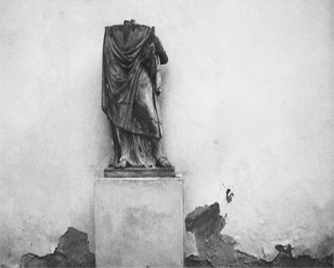Stop – Play – Stop
video
b/n
2’05”
2011
– – –
Nell’universo infinito delle forme, Manuel De Marco ne ha elette alcune a motivo iconografico privilegiato della sua Arte. Tra queste, vi è sicuramente il corpo umano. Tuttavia, il giovane artista lo utilizza raramente nella sua completezza fisica a dimostrazione di una sorta di “immaturità morale” dell’uomo che si riflette anche esteriormente. I “mali” del mondo moderno, la corruzione, il conformismo e il naufragio dei valori, per De Marco si evidenziano proprio in queste figure incomplete o a metà. Nel suo percorso artistico, infatti, appaiono sovente, sia sottoforma di installazioni e sia che si tratti di video. Banditi o ridotti al minimo indispensabile i colori nelle opere tridimensionali, anche nei filmati De Marco opta per il bianco e nero dando origine così ad un linguaggio asciutto ed essenziale che giunge al dunque senza distrarre lo spettatore con fantasmagorie cromatiche. In uno dei suoi ultimi video dal titolo “STOP – PLAY – STOP”, De Marco sceglie volutamente una statua del periodo antico, simbolo per eccellenza di una visione artistica e filosofica che considerava la bellezza esteriore il riflesso di un equilibrio interiore. De Marco però non ce la presenta sotto questa veste e colloca la statua in un’atmosfera di abbandono, di declino fisico, quasi spogliata delle istanze e dei valori che un tempo veicolava. La statua non rappresenta più il passato ma assume in sé le problematiche del mondo moderno ed entra quindi di diritto nel filone delle figure a metà di cui si parlava all’inizio. Con lucida intuizione, il giovane artista capovolge completamente il significato consolidato di un’immagine e ce la mostra sotto una luce nuova.
Ma tra i compiti degli artisti c’è anche quello di aiutare i propri contemporanei ad andare oltre, a non fermarsi all’apparenza fenomenica delle cose e a guardare il mondo con occhi sempre nuovi.
Cristina D’Angelo
– – –
In the infinite universe of forms, Manuel De Marco has chosen some as the privileged iconographic motif of his art. Among these, there is certainly the human body. However, the young artist rarely uses it in its physical completeness, demonstrating a sort of “moral immaturity” of man which is also reflected externally. The “evils” of the modern world, corruption, conformism and the collapse of values, for De Marco are highlighted precisely in these incomplete or half-formed figures. In his artistic career, in fact, they often appear, both in the form of installations and videos. Colors are banned or reduced to the bare minimum in three-dimensional works, even in films De Marco opts for black and white, thus giving rise to a dry and essential language that gets to the point without distracting the viewer with chromatic phantasmagoria. In one of his latest videos entitled “STOP – PLAY – STOP”, De Marco deliberately chooses a statue from the ancient period, the symbol par excellence of an artistic and philosophical vision that considered external beauty the reflection of an internal balance. De Marco, however, does not present it to us in this guise and places the statue in an atmosphere of abandonment, of physical decline, almost stripped of the demands and values that it once conveyed. The statue no longer represents the past but takes on the problems of the modern world and therefore rightfully enters the line of half-figures mentioned at the beginning. With clear intuition, the young artist completely overturns the consolidated meaning of an image and shows it to us in a new light.
But among the tasks of artists there is also that of helping their contemporaries to go further, not to stop at the phenomenal appearance of things and to look at the world with ever new eyes.
Cristina D’Angelo
